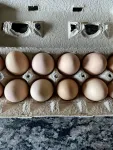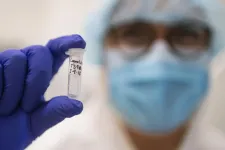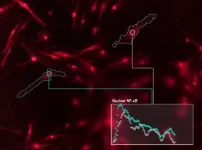(Press-News.org) In 2020, stores sold out of garden seed, coops and rabbit cages. Now, we have an idea how much protein people can grow in their backyards.
The 2020 meat shortages led many to wonder what to eat for protein when supply chains are disrupted. Some people turned to gathering eggs, raising animals and growing their own food. A team from Michigan Technological University and the University of Alaska Fairbanks found that the work is well worth it. In a new study published in Sustainability, the researchers looked at how a typical household with a typical backyard can raise chickens, rabbits or soybeans to meet its protein needs.
People eat a lot of protein in the U.S. and the average person needs 51 grams of protein every day, according to the National Institutes of Health (NIH) Dietary Reference Intakes (DRI). That comes to 18,615 grams each year or, for an average household of 2.6 people, 48,399 grams per year. Americans love burgers, but few people have room to raise a steer next to the garage -- and most city ordinances quake at the mere thought of a rogue cowpie. But small animals are more efficient protein producers and are often allowed within city limits. The average backyard provides plenty of space, typically 800 to 1,000 square meters or about 8,600 to 10,700 square feet.
"You don't have to convert your entire backyard into a soybean farm. A little goes a long way," said Joshua Pearce, one of the study co-authors and Michigan Tech's Richard Witte Endowed Professor of Materials Science and Engineering and professor of electrical and computer engineering. "I'm a solar engineer; I look at surface area and think of photovoltaic production. Many people don't do that -- they don't treat their backyards as a resource. In fact, they can be a time and money sink that they have to mow and pour fertilizer on. But we can actually be very self-reliant when we treat our yards as an asset."
Pearce's co-authors are interdisciplinary and include Michigan Tech students Theresa Meyer and Alexis Pascaris, along with David Denkenberger of the University of Alaska. The lab group originally came together to do an agrovoltaics study to assess raising rabbits under solar panels. But when they sought to purchase cages in spring 2020, they discovered animal equipment and home garden supply shortages throughout the country. Like many labs, the group pivoted and refocused their work to address impacts of the pandemic.
They found that using only backyard resources to raise chickens or rabbits offset protein consumption up to 50%. To reach full protein demand with animals and eggs required buying grain and raising 52 chickens or 107 rabbits. That's more than most city ordinances allow, of course, and raising a critter is not as simple as plopping down a planter box. While pasture-raised rabbits mow the lawn for you, Pearce says the "real winner is soy." Consuming plant protein directly instead of feeding it to animals first is far more efficient. The plant-based protein can provide 80% to 160% of household demand and when prepared as edamame, soy is like a "high-protein popcorn." The team's economic analyses show that savings are possible -- more so when food prices rise -- but savings depend on how people value food quality and personal effort.
"It does take time. And if you have the time, it's a good investment," Pearce said, pointing to other research on building community with gardens, mental health benefits of being outside and simply a deeper appreciation for home-raised food. "Our study showed that many Americans could participate in distributed food production and help make the U.S. not only more sustainable, but more resilient to supply chain disruptions."
INFORMATION:
MINNEAPOLIS/ST.PAUL (05/12/2021) -- In a study recently published in END ...
DURHAM, N.H.-- A national report from the University of New Hampshire shows close to one and a half million children each year visit a doctor, emergency room or medical facility as a result of an assault, abuse, crime or other form of violence. This is four times higher than previous estimates based only on data from U.S. emergency rooms for violence-related treatment.
In their END ...
A portable, rapid testing platform can detect gonorrhea infections in patient samples in under 15 minutes, far faster than standard-of-care tests that can take hours or days. The platform accurately detected infections and determined resistance to a common antibiotic in 217 patient samples from sexual health clinics in Baltimore and Uganda. The technology's speed and low cost could empower quicker and more affordable gonorrhea testing in low-resource regions, as well as help combat the spread of drug-resistant strains. Rates of gonorrhea and other sexually transmitted ...
A new, noninvasive method for measuring brain blood flow with light has been developed by biomedical engineers and neurologists at the University of California, Davis, and used to detect brain activation. The new method, functional interferometric diffusing wave spectroscopy, or fiDWS, promises to be cheaper than existing technology and could be used for assessing brain injuries, or in neuroscience research. The work is published May 12 in Science Advances.
"Now we can assess how well the brain regulates blood flow, and even detect brain activation noninvasively in adult humans, using principles similar to functional ...
MISSOULA - Only an anthropologist would treasure millennia-old human feces found in dry caves.
Just ask Dr. Meradeth Snow, a University of Montana researcher and co-chair of UM's Department of Anthropology. She is part of an international team, led by the Harvard Medical School-affiliated Joslin Diabetes Center, that used human "paleofeces" to discover that ancient people had far different microorganisms living in their guts than we do in modern times.
Snow said studying the gut microbes found in the ancient fecal material may offer clues to combat diseases like diabetes that afflict people living in today's industrialized societies.
"We ...
Researchers used genetic engineering tools to create a virus that can enter specific neurons and insert into the prefrontal cortex a new genetic code that induces the production of modified proteins. In tests with mice, the alteration of these proteins was sufficient to modify brain activity, indicating a potential biomarker for the diagnosis of psychiatric disorders such as schizophrenia and autism.
Sometimes referred to as the "executive brain", the prefrontal cortex is the region that governs higher-level cognitive functions and decision making. Studies of tissue from this brain region in patients with schizophrenia have detected alterations in two proteins: BDNF (brain-derived neurotrophic factor) and trkB (tyrosine receptor kinase B).
The relationship ...
A new study by the University of Georgia revealed that more college students change majors within the STEM pipeline than leave the career path of science, technology, engineering and mathematics altogether.
Funded by a National Institutes of Health grant and a National Science Foundation Postdoctoral Fellowship and done in collaboration with the University of Wisconsin, the study examined interviews, surveys and institutional data from 1,193 students at a U.S. midwestern university for more than six years to observe a single area of the STEM pipeline: biomedical fields of study.
Out of 921 students ...
UCLA life scientists have identified six "words" that specific immune cells use to call up immune defense genes -- an important step toward understanding the language the body uses to marshal responses to threats.
In addition, they discovered that the incorrect use of two of these words can activate the wrong genes, resulting in the autoimmune disease known as Sjögren's syndrome. The research, conducted in mice, END ...
A new study from North Carolina State University finds that greenhouse gas (GHG) emissions from standing dead trees in coastal wetland forests - colloquially called "tree farts" - need to be accounted for when assessing the environmental impact of so-called "ghost forests."
In the study, researchers compared the quantity and type of GHG emissions from dead tree snags to emissions from the soil. While snags did not release as much as the soils, they did increase GHG emissions of the overall ecosystem by about 25 percent. Researchers say the findings show snags are important for understanding the total environmental impact of the spread of dead trees in coastal wetlands, known as ghost forests, ...
The immune system's main job is identifying things that can make us sick. In the language of immunology, this means distinguishing "self" from "non-self": The cells of our organs are self, while disease-causing bacteria and viruses are non-self.
But what about the billions of bacteria that live in our guts and provide us with benefits like digesting food and making vitamins? Are they friend or foe?
This isn't only a philosophical question. An immune system that mistakes our good gut bacteria for an enemy can cause a dangerous type of inflammation in the intestines called colitis. An immune system that looks the other way while gut microbes spill past their assigned borders is equally dangerous. Understanding ...




